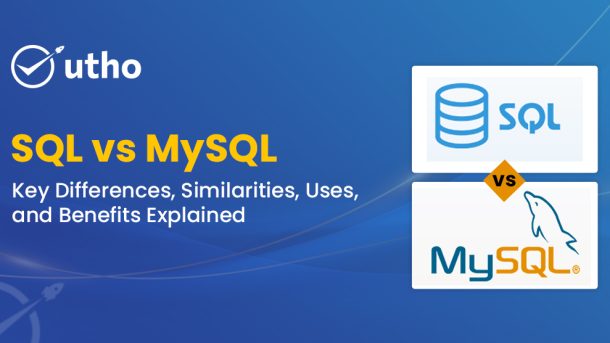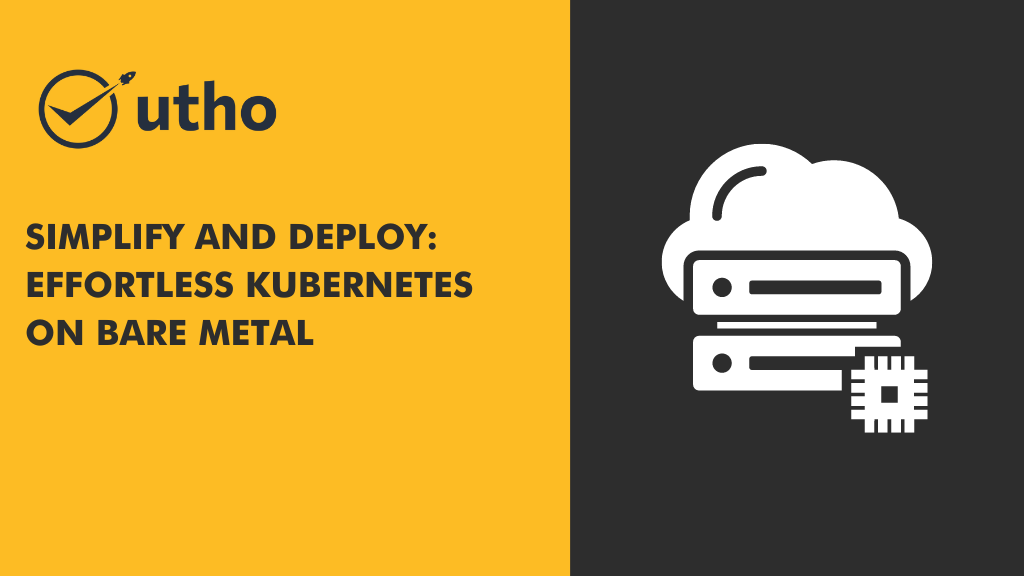In today's data-driven world, data is the backbone of every modern business. Data management is key to your success. It matters for small blogs, big e-commerce sites, and cloud apps for businesses. Two terms you often encounter in this context are SQL and MySQL.
SQL, or Structured Query Language, is a language for interacting with databases. MySQL is a database management system (DBMS) that uses SQL. This difference can confuse beginners. However, understanding it leads to better tech choices and improved application design.
In this article, we’ll look at SQL and MySQL. We’ll discuss how they differ, their similarities, and some real-world uses. We’ll also look at how companies like Utho leverage both for robust cloud solutions.
What is SQL? The Universal Language for Managing Data
Origins and Evolution
SQL stands for Structured Query Language. It was developed in the early 1970s at IBM by Donald D. Chamberlin and Raymond F. Boyce.SQL was first made to manage data in IBM's System R, the first relational database. It provided a simple and standard way to handle structured data. This changed the approach from complex programming methods.
SQL has grown into the universal language for relational databases. Standards like ANSI SQL and ISO SQL have shaped its development. Today, it remains essential for database management.
Core Functionalities of SQL
SQL is a programming language for managing and querying data in relational databases. Its main functions are:
Data Definition Language (DDL) helps you create, modify, and delete database objects. These objects include tables, indexes, and schemas. Examples are CREATE TABLE, ALTER TABLE, and DROP TABLE.
Data Manipulation Language (DML): This allows you to insert, update, and delete data. Commands such as INSERT INTO, UPDATE, and DELETE are part of DML.
- Data Querying: The SELECT statement helps retrieve specific data from large datasets. It often works with clauses like WHERE, GROUP BY, and JOIN.
- Access Control: SQL provides GRANT and REVOKE commands to manage user permissions.
- Transaction Control: Commands like BEGIN, COMMIT, and ROLLBACK ensure atomicity and consistency in data operations.
Why SQL Is Still Relevant
Before SQL, developers used vendor-specific methods or procedural programming to access databases. SQL standardised this process, making it easier to develop cross-platform, interoperable applications. Today, most relational databases support SQL. This includes popular ones like Oracle, PostgreSQL, MySQL, and SQL Server.
How SQL Works: A Basic Overview
SQL queries are executed by a database engine, which parses, optimizes, and returns results. Here are some examples:
SELECT name, email FROM customers WHERE active = 1 ORDER BY name;
This query retrieves the names and emails of all active customers, ordered alphabetically.
Other common queries include:
- INSERT INTO users (name, email) VALUES ('John Doe', '[email protected]');
- UPDATE orders SET status = 'shipped' WHERE order_id = 1024;
- DELETE FROM logs WHERE created_at < '2023-01-01';
What is MySQL? The Popular Database Management System
Introduction to MySQL
MySQL is a common open-source relational database management system (RDBMS) that uses SQL for its queries. MySQL AB created it in 1995. Sun Microsystems bought it in 2008, and then Oracle Corporation acquired it later.
Today, MySQL is used by millions of developers and powers some of the largest websites and apps globally. From startups to enterprises, it offers flexibility, scalability, and community-driven innovation.
Why MySQL Became So Popular
Several factors contribute to MySQL’s widespread adoption:
- Open Source: MySQL is free to use under the GNU General Public License. This means anyone, whether individuals or businesses, can access it. Enterprise-grade versions are available for those needing advanced features and support.
- High Performance: MySQL is built for speed. It efficiently manages large datasets and many users at once.
- Cross-Platform Compatibility: It works well on all major operating systems, like Windows, Linux, and macOS.
- Scalability: Whether you're hosting a small blog or a global e-commerce site, MySQL scales seamlessly with your needs.
- Developer-Friendly Tools: MySQL Workbench, phpMyAdmin, and a strong CLI offer developers visual and command-line interfaces for managing databases.
- Vibrant Community: A big global group shares tools, fixes bugs, writes documents, and offers best practices.
Use Cases of MySQL in the Real World
MySQL runs a wide range of real-world applications in various industries. Its reliability, open-source model, and solid support from hosting platforms make it a preferred option. MySQL powers blogs and supports enterprise-grade business tools. It remains a key technology in the digital world. Below are some common and impactful use cases:
Websites and Content Management Systems (CMS)
MySQL is the backbone of many popular CMS platforms such as WordPress, Joomla, and Drupal. These systems rely on MySQL to store and manage dynamic content like:
- Blog posts and articles
- Pages and layout templates
- User profiles, roles, and permissions
- Comments, tags, and metadata
When a user opens a WordPress blog post, MySQL fetches the content and metadata from the database. Then, it sends this information to the browser. This is great for dynamic websites that need constant updates, tailored content, and easy management.
E-Commerce Platforms
E-commerce platforms like Magento, PrestaShop, and OpenCart rely on MySQL to manage key business data, such as:
- Product catalogs with attributes like price, size, and stock
- Customer records, order histories, and payment details
- Discount codes, coupons, and promotional banners
- Shopping carts and transactional workflows
MySQL helps keep data consistent with its complex queries, indexing, and transactions. This is key during busy times, like flash sales or festive offers. This makes it a go-to choice for small to medium-sized online businesses and marketplace startups.
Data Warehousing and Analytics
MySQL may not be known for big data warehousing, but it’s quite popular for lightweight data warehousing and reporting. This is especially true for small and mid-sized businesses that don’t need big data lakes. It supports:
- Storing cleansed and structured data from operational systems.
- Running scheduled reports and dashboards.
- Powering internal business intelligence tools
Organisations can get valuable insights from data by using MySQL with tools like Apache Superset, Metabase, or Tableau. This way, they avoid the need for complicated infrastructure. This makes MySQL a cost-effective analytics solution for teams with modest data needs.
Custom Business Applications
Many internal tools, enterprise apps, and SaaS platforms use MySQL as their main backend. Some examples include:
- Customer Relationship Management (CRM) systems to store leads, contacts, and interactions
- Enterprise Resource Planning (ERP) software for managing operations, supply chains, and finances
- HR tools for employee records, payroll, and performance tracking.
- Helpdesk systems for managing support tickets and service-level agreements
Developers favour MySQL for custom app development because of:
- Its ease of integration with popular programming languages like PHP, Python, and Java.
- Widespread community support and documentation.
- Reliable performance for both read-heavy and write-heavy workloads.
Mobile and Web App Backends
Startups and developers often use MySQL as the backend database for mobile and web apps due to its simplicity, scalability, and low cost. It helps in:
- Storing user data and authentication details.
- Managing in-app content and user-generated media
- Logging user activity and usage metrics
- Supporting real-time features through polling or lightweight APIs.
MySQL helps teams launch apps quickly when used with frameworks like Laravel, Django, or Spring Boot. This way, they can iterate easily without stressing about infrastructure bottlenecks.
Prototyping and MVP development
MySQL is often chosen for early projects, proof-of-concepts, and Minimum Viable Products (MVPs). It allows teams to:
- Set up databases quickly with minimal configuration.
- Experiment with different data models and features.
- Deploy apps on shared hosting or cloud platforms at a low cost.
It works with almost all major web hosting providers. This makes it a great option for start-ups that want to test ideas with real users.
Key Differences Between SQL and MySQL
Aspect
SQL
MySQL
What it is
A query language
A database management system (DBMS)
Purpose
Used to write and execute database queries.
Stores, manages, and retrieves data using SQL.
Scope
Language standards used across DBMS.
Specific software implementation of an RDBMS.
Updates
Standardised through ANSI/ISO.
Updated by Oracle and the open-source community.
Licensing
Not applicable
Open source (GPL) with enterprise options.
Tools & Interfaces
Varies by database
MySQL Workbench, CLI, phpMyAdmin, connectors, etc.
Knowing these differences helps you choose if you should master SQL as a language or work with a specific system like MySQL. This choice depends on your project or career goals.
Core Similarities Between SQL and MySQL
Despite their technical differences, SQL and MySQL are deeply interconnected.
- Relational Model: Both use the relational database model. They store data in structured tables with rows and columns.
- MySQL relies on SQL commands for key tasks. This includes creating tables, inserting data, and querying records.
- Data integrity: Use primary keys, foreign keys, and constraints to maintain consistency.
- Transaction Support: Both support ACID-compliant transactions. This means you can roll back or commit changes to keep your data safe.
- Data Access: Enable powerful querying capabilities for applications, dashboards, and reporting.
Real-World Applications of SQL and MySQL
When SQL is at the core:
- Data Analysis: SQL fuels tools like Power BI, Tableau, and Google Data Studio. These tools help in querying and analysing structured data.
- ETL Processes: SQL scripts help to extract, transform, and load data across warehouses.
- Database Maintenance: Admins use SQL for indexing, partitioning, and optimising queries.
- Custom Reports: Businesses use SQL to create custom reports. These reports provide insights and help in decision-making.
When MySQL is the preferred DBMS:
- Web Hosting: MySQL is often the default database for shared and VPS hosting.
- E-commerce apps: Shops use MySQL to manage inventory, customer data, and orders in real time.
- Mobile apps: Backend APIs usually save user data, preferences, and activity logs in MySQL databases.
- Microservices: Cloud-native applications deploy MySQL instances in containers and orchestrate them using Kubernetes.
How Utho leverages SQL and MySQL for cloud solutions.
Utho is a modern cloud platform that uses SQL and MySQL. This helps provide strong and scalable solutions.
- Multi-Database Support: Utho works with MySQL and other SQL-based RDBMSs to meet various client needs.
- Optimized Hosting: Pre-configured environments ensure MySQL runs at peak efficiency.
- Backup & Recovery: Automated SQL-based backups ensure business continuity and disaster recovery.
- Security & Access Control: SQL is used to manage granular access permissions and audit logs.
Utho’s infrastructure helps you easily scale your MySQL systems. If you’re developing SaaS products, e-commerce sites, or internal tools, you can leverage SQL’s robust features.
Utho’s Use of SQL and MySQL: Powering India’s Public Cloud
Utho is India’s first public cloud provider. It uses SQL and MySQL to create a cloud platform that is fast, secure, and scalable. SQL makes data querying flexible and efficient. This helps businesses easily retrieve and manage data. MySQL is a strong and dependable database system.
How Utho Uses SQL:
Query Optimisation: Utho's database admins work hard to optimise SQL queries. This helps lower latency and speed up app response times, even when workloads are heavy.
Data Security: SQL permissions control who can access data. This protects sensitive information in a shared cloud setup.
Automation: Tasks like backups, replication, and disaster recovery happen automatically with SQL scripts. This boosts reliability and cuts down on manual mistakes.
How Utho Uses MySQL:
Managed Databases: Utho delivers fully managed MySQL instances. This means customers do not have to worry about setup, maintenance, or monitoring.
High Availability: MySQL clusters use failover systems to provide 99.99% uptime. This keeps critical workloads running smoothly.
Smart Scaling: CPU, memory, and storage adjust automatically. They scale up or down based on demand. This optimises costs and performance without any downtime.
Cloud Integration: MySQL connects easily with other Utho services. This includes Kubernetes, GPU instances, and cloud firewalls. This creates a
Utho combines SQL’s flexible querying with MySQL’s reliability. This gives Indian businesses a cost-effective, secure, and scalable cloud infrastructure. It is designed for today’s data-driven world.
Conclusion: Choosing Between SQL and MySQL
Understanding SQL and MySQL helps you choose the best setup for your data. SQL is a universal language for many database systems. MySQL is a strong, reliable, and popular database system that uses SQL.
At Utho, we blend the best of both worlds. We provide a solid cloud platform. It supports efficient SQL queries and scalable MySQL setups. Everything is tailored to fit your business needs.
Utho offers the performance, security, and ease of use you need. Utho helps developers create SQL queries. It also assists businesses in finding a reliable MySQL cloud service. It helps you thrive in today’s data-driven world.
Ready to simplify your database operations? Check out Utho’s managed SQL and MySQL cloud solutions. Boost your cloud app performance today!




